萨尔瓦多国际经济学(第十版)
- 格式:ppt
- 大小:763.00 KB
- 文档页数:29

吉林大学经济学院《国际经济学》讲义配套教材:国际经济学(萨尔瓦多,第10版)提要一、赫克歇尔-俄林(H-O)定理(要素比例/禀赋理论)【假设条件】国家、要素禀赋和产品设定;偏好相同;技术相同;完全竞争;规模报酬不变;要素内流外不流;无壁垒;资源充分利用;贸易平衡。
【定理表述】两国在贸易前由于要素禀赋的不同,导致了供给能力的差异,进而引起商品相对价格的不同。
根据比较优势原理,一国出口密集使用其丰富要素生产的产品,进口密集使用其稀缺要素生产的产品。
·认为各国的相对要素充裕度(要素禀赋)是贸易中各国具有比较优势的基本原因和决定因素。
·要素价格让相对价格差异变为绝对价格差异,进而导致贸易。
【一般均衡框架】·假设偏好及收入分配一致,则要素供给是影响要素价格唯一原因。
·假设技术一致,要素价格差异导致商品价格差别。
二、要素价格均等(H-O-S)定理【表述】•国际贸易会使各国同质要素获得相同的相对和绝对收入,倾向于缩小两国间工资与利率差别。
•只要要素价格不等,商品价格就不等,继续贸易缩小要素价格差距。
•一国扩大优势品生产会引起充裕要素需求上升价格上涨,所有者收入提高;稀缺要素需求下降价格下跌,所有者收入减少。
【意义】1. 证明在各国要素价格存在差异,而且要素不能在国际间自由流动的情况下,国际贸易可以替代要素国际流动,间接实现世界范围内资源的最佳配置。
2. 说明了贸易利益在一国内部的分配问题。
三、大国征收进口关税的经济效应与福利效应【经济效应】•价格效应:国内价格上升,需求减少,国际价格下降。
•生产效应:国内产量增多。
•消费效应:国内消费减少。
•税收效应:税收收入增加。
•贸易条件效应:关税造成世界价格下降,提供曲线扭曲(向劣势轴偏转),造成贸易条件改善、贸易量减少。
【福利效应】大国收关税在减少贸易量的同时可以拉低国际价格,改善贸易条件。
国家财富增减不一定,取决于两种作用的净效应。
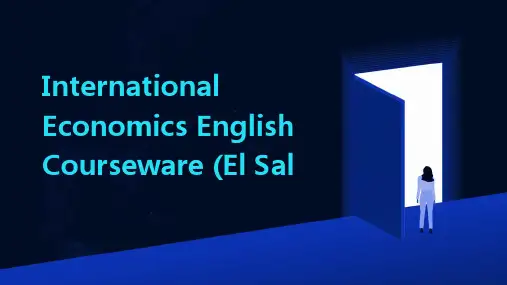
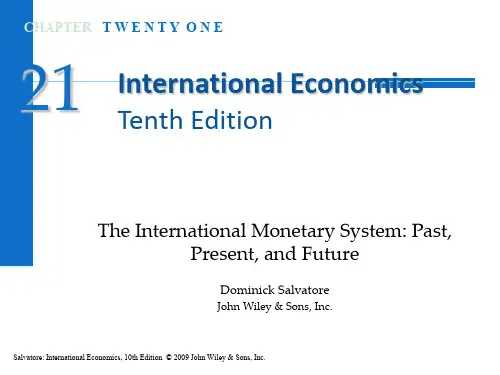
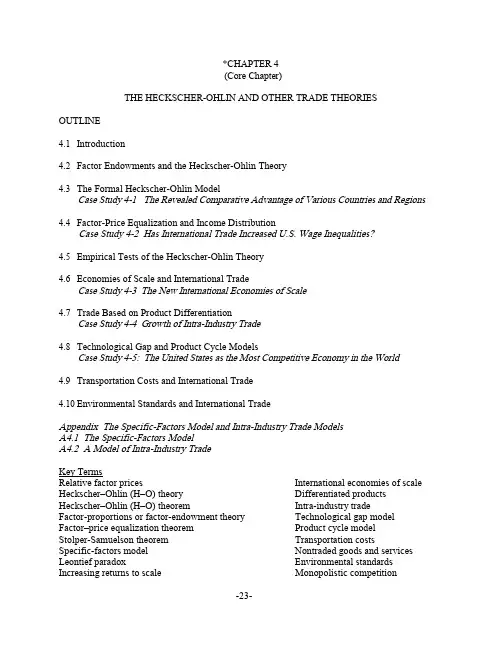
*CHAPTER 4(Core Chapter)THE HECKSCHER-OHLIN AND OTHER TRADE THEORIESOUTLINE4.1 Introduction4.2 Factor Endowments and the Heckscher-Ohlin Theory4.3 The Formal Heckscher-Ohlin ModelCase Study 4-1 The Revealed Comparative Advantage of Various Countries and Regions4.4 Factor-Price Equalization and Income DistributionCase Study 4-2 Has International Trade Increased U.S. Wage Inequalities?4.5 Empirical Tests of the Heckscher-Ohlin Theory4.6 Economies of Scale and International TradeCase Study 4-3 The New International Economies of Scale4.7 Trade Based on Product DifferentiationCase Study 4-4 Growth of Intra-Industry Trade4.8 Technological Gap and Product Cycle ModelsCase Study 4-5: The United States as the Most Competitive Economy in the World4.9 Transportation Costs and International Trade4.10 Environmental Standards and International TradeAppendix The Specific-Factors Model and Intra-Industry Trade ModelsA4.1 The Specific-Factors ModelA4.2 A Model of Intra-Industry TradeKey TermsInternationalofscaleeconomies pricesRelativefactorproducts Heckscher–Ohlin (H–O) theory DifferentiatedtradeIntra-industryHeckscher–Ohlintheorem(H–O)Factor-proportions or factor-endowment theory Technological gap modelcyclemodelProductFactor–price equalization theoremcostsTransportationStolper-Samuelsontheoremmodel Nontraded goods and services Specific-factorsparadox Environmental standardsLeontiefMonopolisticcompetitionscalereturnsIncreasingtoLecture Guide1. This is one of the most important and difficult chapters in the book. It is also a long chapter andrequires four lectures to cover adequately.2. In the first lecture, I would cover sections 1-3. Section 3 is one of the most important sections inthe book because it presents the H-O model. I would proceed slowly and carefully in explaining Figure 4.1 and compare it to the standard trade model of Figure 3.4.3. In the second lecture, I would cover sections 4 and 5. Section 4 on the factor-price equalizationtheorem and income distribution is a difficult section. Case Study 4-2 should be of great interest to the students and give rise to a great deal of class discussion.4. In third lecture, I would cover sections sections 6-7, paying a great deal of attention to section 7on trade in differentiated products.5. In fourth lecture, I would cover the rest of the chapter.Answers to Review Questions and Problems1. a. The Heckscher–Ohlin (H-0) theorem postulates that a nation will export those commodi- ties whose production requires the intensive use of the nation’s relatively abundant and cheap factor and import the commodities whose production requires the intensive useof the nation’s relatively scarce and expensive factor. In short, the relatively labor-richnation exports relatively labor-intensive commodities and imports the relativelycapital-intensive commodities.b. Heckscher and Ohlin identify the relative difference in factor endowments amongnations as the basic determinant of comparative advantage and international trade.c. The H-O Theory represent an extension of the standard trade model because it explains the basis for comparative advantage (classical economists, such as Ricardo had assumed it) and examines the effect of international trade on factor prices and income distribution (which classical economists had left unanswered).2. See Figure 1 on the next page.3. a. The factor–price equalization theorem postulates that international trade will bring about the equalization of the returns to homogeneous or identical factors across nations.b. The Stopler-Samuelson theorem postulates that free international trade reduces the realincome of the nation’s relatively scarce factor and increases the real income of the nation’s relatively abundant factor.Fig 4.1Fig 4.2XXb. The specific-factors model postulates that the opening of trade (1) benefits the specific factorused in the production of the nation’s export commodity, (2) harms the specific factor used in the production of the nation’s import-competing industry, and (3) leads to an ambiguouseffect (i.e., it may benefit or harm) the mobile factor.c. Trade acts as a substitute for the international mobility of factors of production in itseffect on factor prices. With perfect mobility, labor would migrate from the low-wagenation to the high-wage nation until wages in the two nations are equalized. Similarly,capital would move from the low-interest to the high-interest nation until the rate ofinterest was equalized in the two nations.4. a. The Leontief paradox refers to the original Leontief’s finding that U.S. import substituteswere more K-intensive than U.S. exports. This was the opposite of what the H-O theorempostulated.b. The Leontief paradox was resolved by including human capital into the calculations andexcluding industries based on natural resources. Recent research using data on many sectors, for many countries, over many years, and considering that countries could specialize in aparticular subset or group of commodities that were best suited to their specific factorendowments, provides strong support for the H-O theorem.c. The Hecksher-Olhin theory remains the centerpiece of modern trade theory for explaininginternational trade today. To be sure, there are other forces (such as economies of scale,product differentiation, and technological differences across countries) that provide additional reasons and explanations for some international trade not explained by the basic H-O model.These other trade theories complement the basic H-O model in explaining the pattern ofinternational trade in the world today.5. International trade with developing economies, especially newly industrializing economies (NIEs), contributed in two ways to increased wage inequalities between skilled and unskilled workers in the United States during the past two decades. Directly, by reducing the demand for unskilledworkers as a result of increased U.S. imports of labor-intensive manufactures and, indirectly, byspeeding up the introduction of labor-saving innovations, which further reduced the U.S.demand for unskilled workers. International trade, however, was only a small cause of increased wage inequalities in the United States. The most important cause was technological change.6. a. Economies of scale refer to the production situation where output grows proportionatelymore than the increase in inputs or factors of production. For example, output may morethan double with a doubling of inputs.b. Even if two nations were identical in every respect, there is still a basis for mutually bene-ficial trade based on economies of scale. When each nation specializes in the production of one commodity, the combined total world output of both commodities will be greater thanthan without specialization when economies of scale are present. With trade, each nationthen shares in these gains.c. The new international economies of scale refers to the increase in productivity resultingfrom firms purchasing parts and components from nations where they are made cheaperand better, and by establishing production facilities abroad-26-7. a. Product differentiation refers to products that are similar, but not identical. Intra-industrytrade refers to trade in differentiated products, as opposed to inter-industry trade incompletely different products.b. Intra-industry trade arises in order to take advantage of important economies of scale inproduction. That is, with intra-industry trade each firm or plant in industrial countries canspecialize in the production of only one, or at most a few, varieties and styles of the sameproduct rather than many different varieties and styles of a product and achieve economies of scale.c. With few varieties and styles, more specialized and faster machinery can be developedfor a continuous operation and a longer production run. The nation then imports othervarieties and styles from other nations. Intra-industry trade benefits consumers because ofthe wider range of choices (i.e., the greater variety of differentiated products) available atthe lower prices made possible by economies of scale in production.8. a. According to the technological gap model, a firm exports a new product until imitators incountries take away its market. In the meantime, the innovating firm will have introduced a new product or process.b. The criticism of the technological gap model are that it does not explain the size of techno- logical gaps and does not explore the reason for technological gaps arising in the first place, or exactly how they are eliminated over time.c. The five stages of the product cycle model are: the introduction of the product, expansion of production for export, standardization and beginning of production abroad through imitation, foreign imitators underselling the nation in third markets, and foreigners underselling theinnovating firms in their home market as well.9. See Figure 2 on page 25.10. A nation with lower environmental standards can use the environment as a resource endow-ment or as a factor of production in attracting polluting firms from abroad and achieving acomparative advantage in the production of polluting goods and services. This can lead totrade disputes with nations with more stringent environmental standards.-27-Multiple-Choice Questions1. The H-O model extends the classical trade model by:a. explaining the basis for comparative advantageb. examining the effect of trade on factor prices*c. both a and bd. neither a nor b2. A nation is said to have a relative abundance of K if it has a:a. greater absolute amount of Kb. smaller absolute amount of Lc. higher L/K ratio*d. lower price of K in relation to the price of L3. A difference in relative commodity prices between nations can be based on a difference in:a. technologyb. factor endowmentsc. tastes*d. all of the above4. In the H-O model, international trade is based mostly on a difference in:a. technology*b. factor endowmentsc. economies of scaled. tastes5. According to the H-O theory, trade reduces international differences in:a. commodity pricesb. in factor prices*c. both commodity and factor pricesd. neither relative nor absolute factor prices6. According to the Stolper-Samuelson theorem, international trade leads toa. reduction in the real income of the nation’s relatively abundant factor*b. reduction in the real income of the nation’s relatively scarce factorc. increase in the real income of the nation’s relatively scarce factord. none of the above7. Which of the following is false with regard to the specific factors theorem, international trade *a. harms the immobile factors that are specific to the nation’s export commodities or sectorsb. harms the immobile factors that are specific to the nation’s import-competing commoditiesc. has an ambiguous effect on the nation’s mobile factorsd. may benefit or harm the nation’s mobile factors8. Perfect international mobility of factors of productiona. leads to a reduction in international differences in the returns to homogenous factorsb. acts as a substitute for international trade in its effects on factor pricesc. operates on the supply of factors in affecting factor prices*d. all of the above9. The Leontief paradox refers to the empirical finding that U.S.*a. import substitutes were more K-intensive than exportsb. exports were more L-intensive than importsc. exports were more K-intensive than import substitutesd. all of the above10. From empirical studies, we conclude that the H-O theory:a. must be rejectedb. must be accepted without reservations*c. can generally be acceptedd. explains all international trade11. International trade can be based on economies of scale even if both nations have identical:a. factor endowmentsb. tastesc. technology*d. all of the above12. A great deal of international trade:a. is intra-industry tradeb. involves differentiated productsc. is based on monopolistic competition*d. all of the above13. Intra-industry trade takes place:a. because products are homogeneous*b. in order to take advantage of economies of scalec. because perfect competition is the prevalent form of market organizationd. all of the above14. Which of the following statements is true with regard to the product-cycle theory?a. it depends on differences in technological changes over time among countriesb. it depends on the opening and the closing of technological gaps among countriesc. it postulates that industrial countries export more advanced products to lessadvanced countries*d. all of the above15. Transport costs:a. increase the price in the importing countryb. reduces the price in the exporting countryc. falls less heavily on the nation with the more elastic demand and supply curves of the traded commodity*d. all of the above-30-ADDITIONAL ESSAYS AND PROBLEMS FOR PART ONE1. Assume that both the United States and Germany produce beef and computer chips with the following costs:United States Germany(dollars) (marks)Unit cost of beef (B) 2 8Unit cost of computer chips (C) 1 2(a) What is the opportunity cost of beef (B) and computer chips (C) in each country?(b) In which commodity does the United States have a comparative cost advantage?What about Germany?(c) What is the range for mutually beneficial trade between the United States and Germanyfor each computer chip traded?(b) How much would the United States and Germany gain if 1 unit of beef is exchangedfor 3 chips?Answ. (a) In the United States:the opportunity cost of one unit of beef is 2 chips;the opportunity cost of one chip is 1/2 unit of beef.In Germany:the opportunity cost of one unit of beef is 4 chips;the opportunity cost of one chip is 1/4 unit of beef.(b) The United States has a comparative cost advantage in beef with respect to Germany,while Germany has a comparative cost advantage in computer chips.(c) The range for mutually beneficial trade between the United States and Germany foreach unit of beef that the United States exports is2C < 1B < 4C(d) Both the United States and Germany would gain 1 chip for each unit of beef traded.2. Given: (1) two nations (1 and 2) which have the same technology but different factor costs conditions, and (3) no transportation costs, tariffs, or other obstructions to trade.Prove geometrically that mutually advantageous trade between the two nations is possible.Note: Your answer should show the autarky (no-trade) and free-trade points of production and consumption for each nation, the gains from trade of each nation, and express the equilibrium condition that should prevail when trade stops expanding.)Ans.: See the figure below.Fig 4.3Fig 4.4Nations 1 and 2 have different production possibilities curves and different community indifference maps. With these, they will usually end up with different relative commodity prices in autarky, thus making mutually beneficial trade possible.In the figure, Nation 1 produces and consumes at point A and Px/Py=P A in autarky, while Nation 2 produces and consumes at point A' and Px/Py=P A'. Since P A < P A', Nation 1 has a comparative advantage in X and Nation 2 in Y. Specialization in production proceeds until point B in Nation 1 and point B' in Nation 2, at which P B =P B' and the quantity supplied for export of each commodity exactly equals the quantity demanded for import.Thus, Nation 1 starts at point A in production and consumption in autarky, moves to point B in production, and by exchanging BC of X for CE of Y reaches point E in consumption. E > A since it involves more of both X and Y and lies on a higher community indifference curve.Nation 2 starts at A' in production and consumption in autarky, moves to point B' in production, and by exchanging B'C' of Y for C'E' of X reaches point E'in consumption (which exceeds A').At Px/Py=P B =P B', Nation 1 wants to export BC of X for CE of Y, while Nation 2 wants to export B'C' (=CE) of Y for C'E' (=BC) of X. Thus, P B =P B' is the equilibrium relative commodity price because it clears both (the X and Y) markets.3. (a) Identify the conditions that may give rise to trade between two nations. (b) What aresome of the assumptions on which the Heckscher-Ohlin theory is based? (c) What does this theory say about the pattern of trade and effect of trade on factor prices?Ans. (a) Trade can be based on a difference in factor endowments, technology, or tastesbetween two nations. A difference either in factor endowments or technology results in a different production possibilities frontier for each nation, which, unlessneutralized by a difference in tastes, leads to a difference in relative commodity price and mutually beneficial trade. If two nations face increasing costs and have identical production possibilities frontiers but different tastes, there will also be a differencein relative commodity prices and the basis for mutually beneficial trade between the two nations. The difference in relative commodity prices is then translated into adifference in absolute commodity prices between the two nations, which is the immediate cause of trade.(b) The Heckscher-Ohlin theory (sometimes referred to as the modern theory – asopposed to the classical theory - of international trade) assumes that nations have the same tastes, use the same technology, face constant returns to scale (i.e., a givenpercentage increase in all inputs increases output by the same percentage) but differ widely in factor endowments. It also says that in the face of identical tastes or demand conditions, this difference in factor endowments will result in a difference in relative factor prices between nations, which in turn leads to a difference in relativecommodity prices and trade. Thus, in the Heckscher-Ohlin theory, the internationaldifference in supply conditions alone determines the pattern of trade. To be noted is that the two nations need not be identical in other respects in order for internationaltrade to be based primarily on the difference in their factor endowments.(c) The Heckscher-Ohlin theorem postulates that each nation will export the commodityintensive in its relatively abundant and cheap factor and import the commodityintensive in its relatively scarce and expensive factor. As an important corollary, itadds that under highly restrictive assumptions, trade will completely eliminate thepretrade relative and absolute differences in the price of homogeneous factors amongnations. Under less restrictive and more usual conditions, however, trade will reduce, but not eliminate, the pretrade differences in relative and absolute factor prices among nations. In any event, the Heckscher-Ohlin theory does say something very useful onhow trade affects factor prices and the distribution of income in each nation. Classical economists were practically silent on this point.-33-4. Suppose that tastes change in Nation 1 (the L-abundant and L-cheap nation) so that consumers demand more of commodity X (the L-intensive commodity) and less of commodity Y (the K- intensive commodity). Suppose that Nation 1 is India, commodity X is textiles, and commodi- ty Y is food. Starting from the no-trade equilibrium position and using the Heckscher-Ohlinmodel, trace the effect of this change in tastes on India's (a) relative commodity prices anddemand for food and textiles, (b) production of both commodities and factor prices, and(c) comparative advantage and volume of trade. (d) Do you expect international trade to leadto the complete equalization of relative commodity and factor prices between India and theUnited States? Why?Ans. (a) The change in tastes can be visualized by a shift toward the textile axis in India'sindifference map in such a way that an indifference curve is tangent to the steepersegment of India's production frontier (because of increasing opportunity costs) after the increase in demand for textiles. This will cause the pretrade relative commodity price of textiles to rise in India.(b) The increase in the relative price of textiles will lead domestic producers in India toshift labor and capital from the production of food to the production of textiles. Since textiles are L-intensive in relation to food, the demand for labor and therefore the wage rate will rise in India. At the same time, as the demand for food falls, thedemand for and thus the price of capital will fall. With labor becoming relative more expensive, producers in India will substitute capital for labor in the production of both textiles and food.(c) Even with the rise in relative wages and in the relative price of textiles, India stillremains the L-abundant and low-wage nation with respect to a nation such as theUnited States. However, the pretrade difference in the relative price of textilesbetween India and the United States is now somewhat smaller than before the change in tastes in India. As a result the volume of trade required to equalize relativecommodity prices and hence factor prices is smaller than before. That is, India need now export a smaller quantity of textiles and import less food than before for therelative price of textiles in India and the United States to be equalized. Similarly, the gap between real wages and between India and the United States is now smaller and can be more quickly and easily closed (i.e., with a smaller volume of trade).(d) Since many of the assumptions required for the complete equalization of relativecommodity and factor prices do not hold in the real world, great differences can be expected and do in fact remain between real wages in India and the United States.Nevertheless, trade would tend to reduce these differences, and the H-O model does identify the forces that must be considered to analyze the effect of trade on thedifferences in the relative and absolute commodity and factor prices between Indiaand the United States.-34-5. (a) Explain why the Heckscher-Ohlin trade model needs to be extended. (b) Indicate in what important ways the Heckscher-Ohlin trade model can be extended. (c) Explain what ismeant by differentiated products and intra-industry trade.Ans. (a) The Heckscher-Ohlin trade model needs to be extended because, while generallycorrect, it fails to explain a significant portion of international trade, particularly the trade in manufactured products among industrial nations.(b) The international trade left unexplained by the basic Heckscher-Ohlin trade model canbe explained by (1) economies of scale, (2) intra-industry trade, and (3) trade based on imitation gaps and product differentiation.(c) Differentiated products refer to similar, but not identical, products (such as cars,typewriters, cigarettes, soaps, and so on) produced by the same industry or broadproduct group. Intra-industry trade refers to the international trade in differentiated products.-35-。
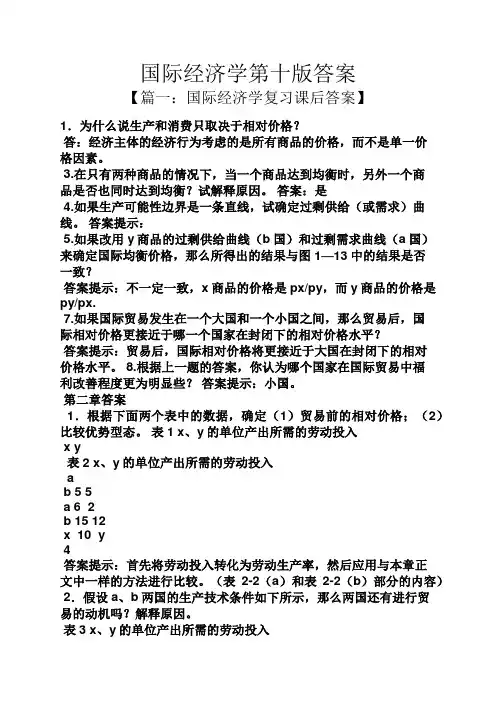
国际经济学第十版答案【篇一:国际经济学复习课后答案】1.为什么说生产和消费只取决于相对价格?答:经济主体的经济行为考虑的是所有商品的价格,而不是单一价格因素。
3.在只有两种商品的情况下,当一个商品达到均衡时,另外一个商品是否也同时达到均衡?试解释原因。
答案:是4.如果生产可能性边界是一条直线,试确定过剩供给(或需求)曲线。
答案提示:5.如果改用y商品的过剩供给曲线(b国)和过剩需求曲线(a国)来确定国际均衡价格,那么所得出的结果与图1—13中的结果是否一致?答案提示:不一定一致,x商品的价格是px/py,而y商品的价格是py/px.7.如果国际贸易发生在一个大国和一个小国之间,那么贸易后,国际相对价格更接近于哪一个国家在封闭下的相对价格水平?答案提示:贸易后,国际相对价格将更接近于大国在封闭下的相对价格水平。
8.根据上一题的答案,你认为哪个国家在国际贸易中福利改善程度更为明显些?答案提示:小国。
第二章答案1.根据下面两个表中的数据,确定(1)贸易前的相对价格;(2)比较优势型态。
表1 x、y的单位产出所需的劳动投入x y表2 x、y的单位产出所需的劳动投入ab 5 5a 6 2b 15 12x 10 y4答案提示:首先将劳动投入转化为劳动生产率,然后应用与本章正文中一样的方法进行比较。
(表2-2(a)和表2-2(b)部分的内容) 2.假设a、b两国的生产技术条件如下所示,那么两国还有进行贸易的动机吗?解释原因。
表3 x、y的单位产出所需的劳动投入x ya 4 2b 8 4答案提示:从绝对优势来看,两国当中a国在两种产品中都有绝对优势;从比较优势来看,两国不存在相对技术差异。
所以,两国没有进行国际贸易的动机。
3.如果一国在某一商品上具有绝对优势,那么也必具有比较优势吗?答案提示:不一定,比较优势的确定原则是两优取最优,两劣取最劣。
5.假设某一国家拥有20,000万单位的劳动,x、y的单位产出所要求的劳动投入分别为5个单位和4个单位,试确定生产可能性边界方程。
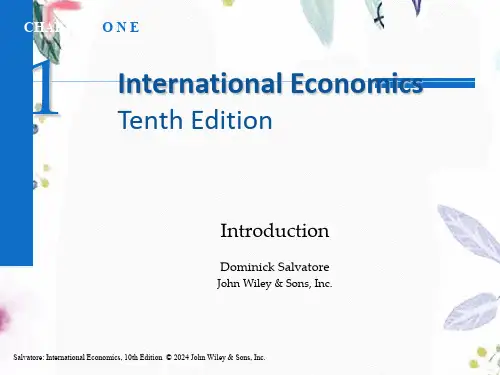
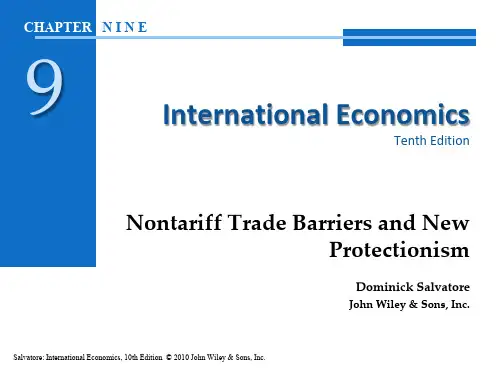
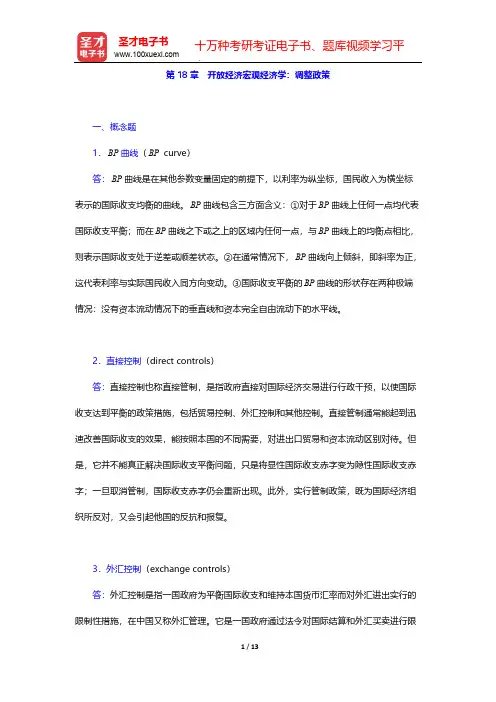
第18章 开放经济宏观经济学:调整政策一、概念题1.曲线( curve)BP BP答:曲线是在其他参数变量固定的前提下,以利率为纵坐标,国民收入为横坐标BP表示的国际收支均衡的曲线。
曲线包含三方面含义:①对于曲线上任何一点均代表BP BP国际收支平衡;而在曲线之下或之上的区域内任何一点,与曲线上的均衡点相比,BP BP则表示国际收支处于逆差或顺差状态。
②在通常情况下,曲线向上倾斜,即斜率为正,BP这代表利率与实际国民收入同方向变动。
③国际收支平衡的曲线的形状存在两种极端BP情况:没有资本流动情况下的垂直线和资本完全自由流动下的水平线。
2.直接控制(direct controls)答:直接控制也称直接管制,是指政府直接对国际经济交易进行行政干预,以使国际收支达到平衡的政策措施,包括贸易控制、外汇控制和其他控制。
直接管制通常能起到迅速改善国际收支的效果,能按照本国的不同需要,对进出口贸易和资本流动区别对待。
但是,它并不能真正解决国际收支平衡问题,只是将显性国际收支赤字变为隐性国际收支赤字;一旦取消管制,国际收支赤字仍会重新出现。
此外,实行管制政策,既为国际经济组织所反对,又会引起他国的反抗和报复。
3.外汇控制(exchange controls)答:外汇控制是指一国政府为平衡国际收支和维持本国货币汇率而对外汇进出实行的限制性措施,在中国又称外汇管理。
它是一国政府通过法令对国际结算和外汇买卖进行限制的一种限制进口的国际贸易政策。
外汇控制分为数量控制和成本控制。
前者是指国家外汇管理机构对外汇买卖的数量直接进行限制和分配,通过控制外汇总量达到限制出口的目的;后者是指,国家外汇管理机构对外汇买卖实行复汇率制,利用外汇买卖成本的差异,调节进口商品结构。
4.支出—改变政策(expenditure-changing policies)答:支出—改变政策是指政府通过财政政策来改变经济中对商品和劳务的总需求水平,从而实现内外均衡的政策。
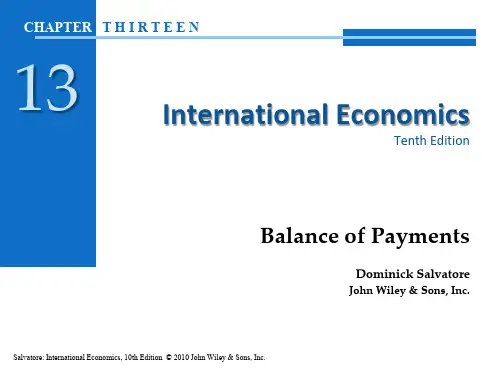
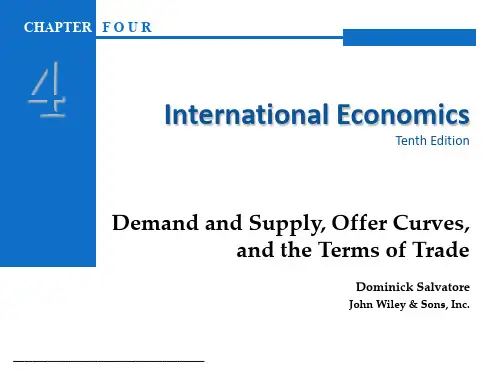
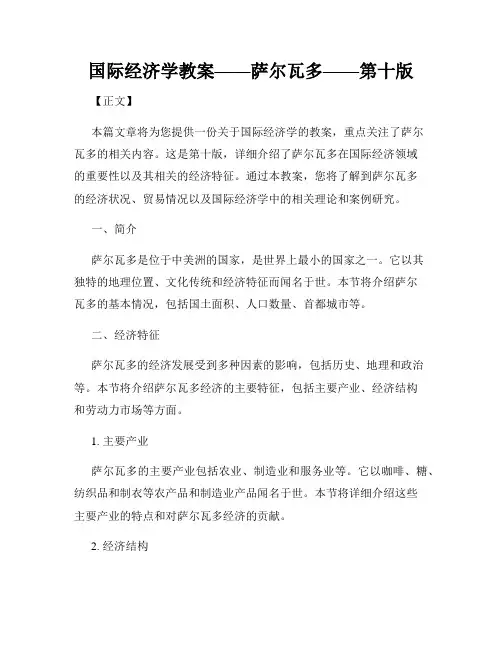
国际经济学教案——萨尔瓦多——第十版【正文】本篇文章将为您提供一份关于国际经济学的教案,重点关注了萨尔瓦多的相关内容。
这是第十版,详细介绍了萨尔瓦多在国际经济领域的重要性以及其相关的经济特征。
通过本教案,您将了解到萨尔瓦多的经济状况、贸易情况以及国际经济学中的相关理论和案例研究。
一、简介萨尔瓦多是位于中美洲的国家,是世界上最小的国家之一。
它以其独特的地理位置、文化传统和经济特征而闻名于世。
本节将介绍萨尔瓦多的基本情况,包括国土面积、人口数量、首都城市等。
二、经济特征萨尔瓦多的经济发展受到多种因素的影响,包括历史、地理和政治等。
本节将介绍萨尔瓦多经济的主要特征,包括主要产业、经济结构和劳动力市场等方面。
1. 主要产业萨尔瓦多的主要产业包括农业、制造业和服务业等。
它以咖啡、糖、纺织品和制衣等农产品和制造业产品闻名于世。
本节将详细介绍这些主要产业的特点和对萨尔瓦多经济的贡献。
2. 经济结构萨尔瓦多经济的结构主要由农业、制造业和服务业构成。
本节将分析这些行业在萨尔瓦多经济中的比重,并探讨其对GDP和就业的影响。
3. 劳动力市场萨尔瓦多的劳动力市场状况对经济发展起着重要作用。
本节将介绍萨尔瓦多的劳动力市场现状,包括就业率、失业率和工资水平等方面的情况,并探讨其中的挑战和机遇。
三、贸易状况贸易对于萨尔瓦多的经济增长和发展至关重要。
本节将详细介绍萨尔瓦多的进出口情况,包括主要贸易伙伴、贸易顺差/逆差以及贸易政策等方面的内容。
1. 主要贸易伙伴萨尔瓦多的主要贸易伙伴包括美国、中国、哥伦比亚等国家。
本节将分析这些国家与萨尔瓦多的贸易合作情况,并探讨其中的优势和劣势。
2. 贸易顺差/逆差萨尔瓦多的贸易顺差/逆差对于国家经济稳定与发展起着重要作用。
本节将介绍萨尔瓦多的贸易顺差/逆差情况,并分析其原因和影响。
3. 贸易政策贸易政策对于萨尔瓦多的经济发展具有重要意义。
本节将介绍萨尔瓦多的贸易政策,包括关税政策、自由贸易协定和贸易保护主义等方面的内容。
国际经济学(第十版)多米尼克.萨尔瓦多(著) P16页练习题6.(1)根据消费者需求理论,当其他条件不变时,一种商品价格的提高(如由于税率的上浮所致),会带来需求量的什么变化?答:根据消费者需求理论,当其他条件不变时,一种商品价格的提高,则该商品的需求量将会下降。
(2)根据消费者需求理论,一种进口商品价格的提高(如由于进口关税的上浮所致),会带来需求量的什么变化?答:根据消费者需求理论,一种进口商品价格的提高,则该商品的出口量将会下降。
7.(1)一国政府如何能消除或减少预算赤字?答:一国政府可以通过减少政府支出、增加税收,来消除或者减少预算赤字。
(2)一个国家如何能消除或减少贸易逆差?答:一个国家要消除或减少其贸易逆差的方式有:对进口商品增税、补贴出口,借如更多的国外债券、减少借出外国债券,降低该国的国民收入水平。
8.(1)国际经济关系与地区经济关系有何区别?答:在国际经济关系下,国家通常限制在国际间的自由流动的货物、服务和因素,不同的语言、消费习惯和法律规定同样也阻碍了它们在国际间的流动,此外,国际收支会在各种货币收据和付款中流通。
而在地区经济关系下,就关税和进行相同的货币而言,区际流动的货物、服务和因素没有面临这样的限制因素,它们经常是在同样的语言环境下,在类似的消费习惯和法律规定下进行的,这就与国际经济关系形成了鲜明对比。
(2)它们在哪方面相似?答:国际经济关系和地区经济关系的相似点:两者都跨越了空间距离,事实上,它们都是在远距离贸易下的产物,把经济看待成在一个进行着生产、交换和消费的空间中的单一点,这也是从经济学的复位空间将它们区分。
10.如果说一个国家可以从国际贸易中获益,那么你如何解释为什么许多国家又要对国际贸易施加某些限制?答:国际贸易给本国消费者带来的是更低的价格,这样就会对本国的同种商品的生产商造成不利,挤兑了本国生产商的销售份额。
通常在这种情况下,本国的生产商就会失去大量的订单,并且向政府提议限制进口。
国际经济学第十版课后答案(萨尔瓦多、杨冰译)国际经济学(第十版)多米尼克.萨尔瓦多(著)P16页练习题6. (1)根据消费者需求理论,当其他条件不变时,一种商品价格的提高(如由于税率的上浮所致),会带来需求量的什么变化?答:根据消费者需求理论,当其他条件不变时,一种商品价格的提高,则该商品的需求量将会下降。
(2)根据消费者需求理论,一种进口商品价格的提高(如由于进口关税的上浮所致) ,会带来需求量的什么变化?答:根据消费者需求理论,一种进口商品价格的提高,则该商品的出口量将会下降。
7. (1) 一国政府如何能消除或减少预算赤字?答:一国政府可以通过减少政府支出、增加税收,来消除或者减少预算赤字。
(2) 一个国家如何能消除或减少贸易逆差?答:一个国家要消除或减少其贸易逆差的方式有:对进口商品增税、补贴出口,借如更多的国外债券、减少借出外国债券,降低该国的国民收入水平。
8 (1)国际经济关系与地区经济关系有何区别?答:在国际经济关系下,国家通常限制在国际间的自由流动的货物、服务和因素,不同的语言、消费习惯和法律规定同样也阻碍了它们在国际间的流动,此外,国际收支会在各种货币收据和付款中流通。
而在地区经济关系下,就关税和进行相同的货币而言,区际流动的货物、服务和因素没有面临这样的限制因素,它们经常是在同样的语言环境下,在类似的消费习惯和法律规定下进行的,这就与国际经济关系形成了鲜明对比。
(2)它们在哪方面相似?答:国际经济关系和地区经济关系的相似点:两者都跨越了空间距离,事实上,它们都是在远距离贸易下的产物,把经济看待成在一个进行着生产、交换和消费的空间中的单一点,这也是从经济学的复位空间将它们区分。
10.如果说一个国家可以从国际贸易中获益,那么你如何解释为什么许多国家又要对国际贸易施加某些限制?答:国际贸易给本国消费者带来的是更低的价格,这样就会对本国的同种商品的生产商造成不利,挤兑了本国生产商的销售份额。